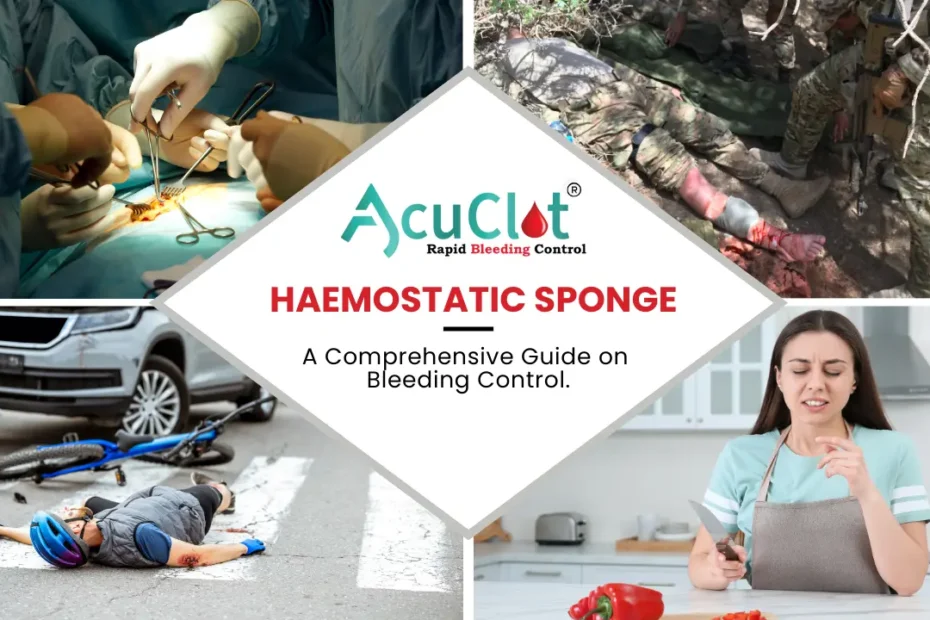Haemostatic sponges are revolutionary medical devices designed to stop bleeding quickly and efficiently. These sponges are utilized in operations, cases of emergency, and also when one has a minor injury. Thus, they are easy to use and very quick, which makes them a go-to solution in medical facilities when it comes to blood loss.
This article will delve deep into the concept of haemostatic sponges, with a specific focus on AcuClot – Bleeding Control, a highly effective bleeding control solution. But do you know how these sponges are effective, with its primary uses, and the scientific principles behind them?
What is a Haemostatic Sponge?
How Does It Work?
A haemostatic sponge works by promoting rapid clot formation at the bleeding site. What happens is that when the sponge is applied on the wound, it soaks the blood and also stimulates the blood clotting process. Fibrinogen is one such plasma protein that quickly forms a clot, thereby acting as a sort of plug to stop the bleeding at the site of the injury.
Benefits of Using Haemostatic Sponges
1 Quick Bleeding Control
Haemostatic sponges are designed to stop bleeding within minutes, which is crucial in emergency and surgical settings.
2 Reducing Blood Loss
They prevent blood loss because the sponges formed clots very fast, therefore little adverse effects such as shock would be experienced.
3 Easy to Use
These sponges do not need any specialized tools or equipment for its application and therefore can be used in situations which are at a field or emergency.
AcuClot: A Leader in Bleeding Control Solutions
AcuClot is one of the leading haemostatic sponges available in the market today. You can learn more about this innovative product by visiting the AcuClot’s Product Page.
Features of AcuClot
1 Rapid Hemostasis:
AcuClot ensures faster clot formation, effectively reducing bleeding time.
2 Safe and Sterile:
This is non toxic item and is produced under sterile conditions hence it does not harbor any germs.
3 Versatile Application:
The settings that this glove is ideal for use include surgical, trauma, and minor wound settings.
How AcuClot Stands Out?
AcuClot’s unique formulation and easy-to-use design make it one of the most trusted haemostatic sponges for bleeding control. It has a very wide usage, and at the same time its usage is effective and guarantees maximum efficacy.
When and Where to Use Haemostatic Sponges?
1 Surgical Settings
Haemostatic sponges are widely used in surgeries to manage bleeding during procedures. Larger clumps of those fibers can be applied directly to a site where active bleeding is occurring which makes surgeries less risky and quicker.
2 Trauma and Emergencies
In emergency situations, where rapid bleeding control is essential, haemostatic sponges are indispensable. They can be employed by EMS personnel to control blood loss to a level that cannot be achieved in the operating room.
3 Minor Cuts and Injuries
Even for minor cuts, a haemostatic sponge can be an excellent tool for stopping bleeding quickly and preventing infection.
The Science Behind Haemostatic Sponges
How They Interact with Blood?
Haemostatic sponges work by interacting with blood platelets and proteins to enhance the clotting process. they also help the framework of the sponge to interject these components, even if not common, making the parts of the blood to find each other easily as they form clots.
Activation Of Coagulation Cascade
Coagulation factors are a complex set of events the body undergoes in order to check hemorrhaging. Haemostatic sponges activate this cascade by providing a surface for clotting factors to gather and form a stable clot.
Benefits over the conventional approaches:
1 Faster Bleeding Control
Traditional methods like gauze or pressure bandages may not stop bleeding as quickly as a haemostatic sponge. The sponge begins clotting almost immediately and is thus more effective in emergency situations than tiny meshes.
2 Lower Risk of Infection
Because haemostatic sponges are often sterile, they reduce the risk of infection at the wound site compared to traditional bandages or cloths.
3 Application and removal process
Unlike some traditional methods, haemostatic sponges are easy to apply and remove, reducing discomfort for the patient.
How to Apply a Haemostatic Sponge?
- Clean the Wound: Ensure the wound is clean before applying the haemostatic sponge.
- Apply the Sponge: Apply the sponge wet on the affected area.
- Apply Pressure: Allow the sponge to remain in position for sometime to allow bonding or clot formation.
- Monitor the Wound: In few minutes the bleeding should stop, inspect the wound carefully to make sure bleeding has ceased.
Removal Instructions
Haemostatic sponges typically dissolve or can be gently removed once clotting is complete. Remember always to stick to a doctor’s word when it comes to removal.
Risk reduction and Prevention Measures
Allergic Reactions
Some patients may be allergic to the materials used in haemostatic sponges, such as collagen. This product should always be checked for allergies before use.
Avoiding Overuse
Haemostatic sponges are powerful tools, but they should not be overused or applied to non-bleeding areas. Points that one should follow when applying the products:
Conclusion
Haemostatic sponges are essential medical devices that provide quick and effective bleeding control. With products like AcuClot leading the way, they are becoming more accessible and practical for use in various medical and emergency settings. Always consult a healthcare provider for advice on proper use, and remember to keep haemostatic sponges on hand for unexpected injuries.
For support, you can contact us at care@anziam.com or call us at +91-7976625409.

